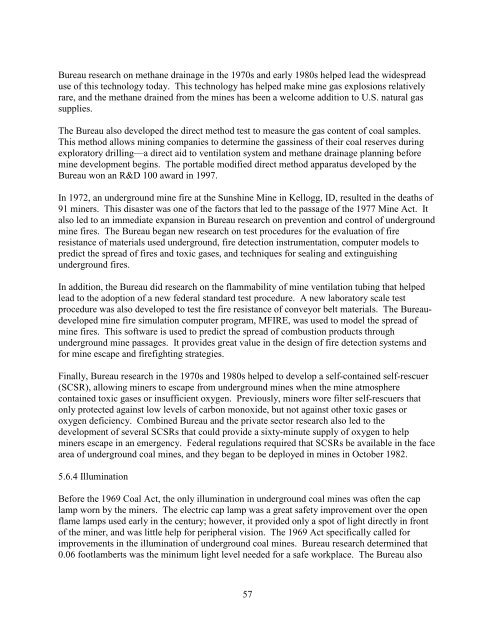One Hundred Years of Federal Mining Safety and Health Research
One Hundred Years of Federal Mining Safety and Health Research
One Hundred Years of Federal Mining Safety and Health Research
- No tags were found...
Create successful ePaper yourself
Turn your PDF publications into a flip-book with our unique Google optimized e-Paper software.
Bureau research on methane drainage in the 1970s <strong>and</strong> early 1980s helped lead the widespread<br />
use <strong>of</strong> this technology today. This technology has helped make mine gas explosions relatively<br />
rare, <strong>and</strong> the methane drained from the mines has been a welcome addition to U.S. natural gas<br />
supplies.<br />
The Bureau also developed the direct method test to measure the gas content <strong>of</strong> coal samples.<br />
This method allows mining companies to determine the gassiness <strong>of</strong> their coal reserves during<br />
exploratory drilling—a direct aid to ventilation system <strong>and</strong> methane drainage planning before<br />
mine development begins. The portable modified direct method apparatus developed by the<br />
Bureau won an R&D 100 award in 1997.<br />
In 1972, an underground mine fire at the Sunshine Mine in Kellogg, ID, resulted in the deaths <strong>of</strong><br />
91 miners. This disaster was one <strong>of</strong> the factors that led to the passage <strong>of</strong> the 1977 Mine Act. It<br />
also led to an immediate expansion in Bureau research on prevention <strong>and</strong> control <strong>of</strong> underground<br />
mine fires. The Bureau began new research on test procedures for the evaluation <strong>of</strong> fire<br />
resistance <strong>of</strong> materials used underground, fire detection instrumentation, computer models to<br />
predict the spread <strong>of</strong> fires <strong>and</strong> toxic gases, <strong>and</strong> techniques for sealing <strong>and</strong> extinguishing<br />
underground fires.<br />
In addition, the Bureau did research on the flammability <strong>of</strong> mine ventilation tubing that helped<br />
lead to the adoption <strong>of</strong> a new federal st<strong>and</strong>ard test procedure. A new laboratory scale test<br />
procedure was also developed to test the fire resistance <strong>of</strong> conveyor belt materials. The Bureaudeveloped<br />
mine fire simulation computer program, MFIRE, was used to model the spread <strong>of</strong><br />
mine fires. This s<strong>of</strong>tware is used to predict the spread <strong>of</strong> combustion products through<br />
underground mine passages. It provides great value in the design <strong>of</strong> fire detection systems <strong>and</strong><br />
for mine escape <strong>and</strong> firefighting strategies.<br />
Finally, Bureau research in the 1970s <strong>and</strong> 1980s helped to develop a self-contained self-rescuer<br />
(SCSR), allowing miners to escape from underground mines when the mine atmosphere<br />
contained toxic gases or insufficient oxygen. Previously, miners wore filter self-rescuers that<br />
only protected against low levels <strong>of</strong> carbon monoxide, but not against other toxic gases or<br />
oxygen deficiency. Combined Bureau <strong>and</strong> the private sector research also led to the<br />
development <strong>of</strong> several SCSRs that could provide a sixty-minute supply <strong>of</strong> oxygen to help<br />
miners escape in an emergency. <strong>Federal</strong> regulations required that SCSRs be available in the face<br />
area <strong>of</strong> underground coal mines, <strong>and</strong> they began to be deployed in mines in October 1982.<br />
5.6.4 Illumination<br />
Before the 1969 Coal Act, the only illumination in underground coal mines was <strong>of</strong>ten the cap<br />
lamp worn by the miners. The electric cap lamp was a great safety improvement over the open<br />
flame lamps used early in the century; however, it provided only a spot <strong>of</strong> light directly in front<br />
<strong>of</strong> the miner, <strong>and</strong> was little help for peripheral vision. The 1969 Act specifically called for<br />
improvements in the illumination <strong>of</strong> underground coal mines. Bureau research determined that<br />
0.06 footlamberts was the minimum light level needed for a safe workplace. The Bureau also<br />
57
















